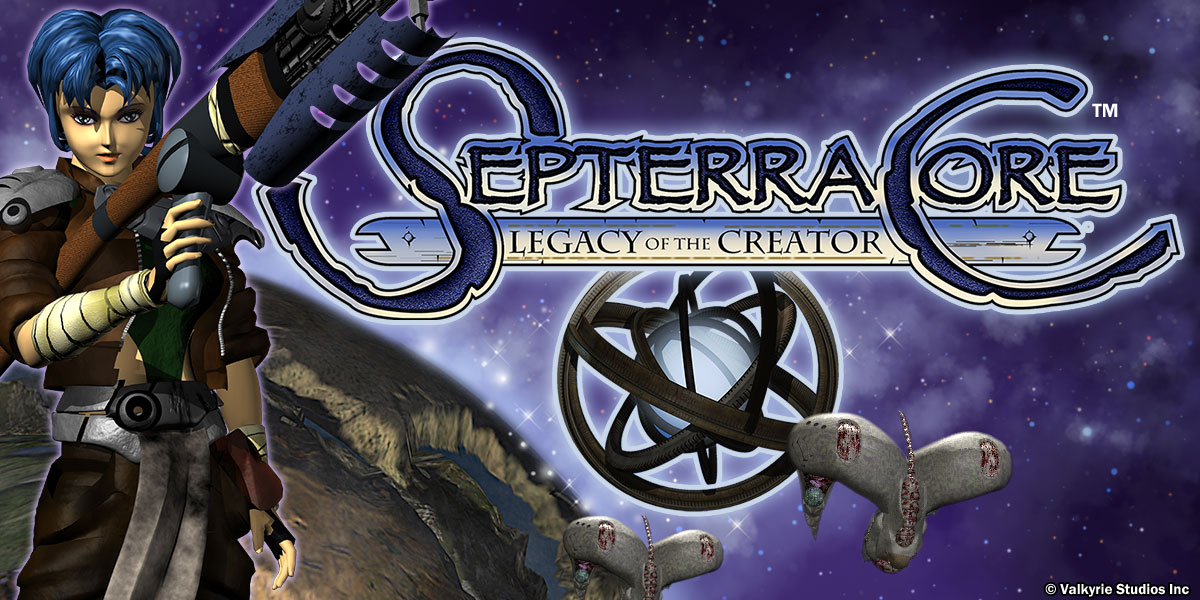Septerra Core: Legacy of the Creator marked its 20th anniversary since publication late in 2019. What follows is a deep dive retrospective on the making of this cult classic RPG!
(BTW – In case you missed them, here’s Part 01, Part 02, Part 03, and Part 04)
In late 1996 / early 1997 Viacom New media (VNM) was shutting down operations. The Septerra Core team quickly found ourselves out of work. But a small group came together to pursue the rights to the game. Could we rise from the ashes of VNM and start our own company?
Valkyrie Rises
Cathi Court (Producer), Alisa Kober (co-Lead Artist), Roger D (Tools Programming), and myself (Lead Game Design) had decided to band together and fight to keep Septerra Core alive. We were doing this while VNM was shutting down—the offices were still there, but there was only a shoestring of people remaining as the employees were being let go in waves.
To our surprise Viacom corporate actually agreed to sit down and talk with us. Why not? The company had no plans to pursue the project, so there was nothing to gain by holding on to it: we could have the rights to the game, including all assets and intellectual property, for a pittance.
Shocking, right? A giant corporate empire was willing to do right by its (former and soon to be former) employees.
“…(For) all the other things they may have done wrong, Viacom did give us enough of a head start on development that when the crap hit the prop there, we had enough to go out and pitch to someone else to fund it ….they were actually quite generous in essentially handing us the rights in the end, and largely giving us a whole lot of what we needed to set up shop in the first place, so we could try.“
-Cathi Court
With a deal secured we were ready to get to work.
But I wasn’t so sure.
I was the youngest of our little start-up, even if by a year or so, and a naturally pessimistic dude (my spirit animal is probably Grumpy the Dwarf). Could we really secure the million+ dollars we would need to fund development? I was a game designer, more at home with storytelling and balancing gameplay than running a company. For over a year I had been leading the way as the cheerleader for Septerra Core, convincing others to join me on this endeavor with not much more than passion for my grand little idea. But now it was suddenly Cathi, Alisa, and Roger who had to convince me that this was something we could do, something worth fighting for.
And it was their enthusiasm that won me over. That’s one of the things that was so special about Septerra Core at VNM: the team had always rallied behind the game. This idea I had developed had attracted all this enthusiasm. How could I be anything but humbled by that?
Maybe we had little chance of pulling it off, but if I didn’t even try? Septerra Core, this game we had spent a year on developing, would simply disappear. I have no doubt that it would have become my white whale, the one that got away and would haunt me for the rest of my career.
I couldn’t let that happen.
So form a company we did. But what to call it? I had an idea.
In Norse mythology, the Valkyries are the maidens of Odin who swoop down to the battlefield in the aftermath of war, selecting from the dead those worthy to join the All-father in Valhalla and live out their afterlife doing what they loved in life: fighting.
And like those mythical shield maidens we hoped to bring many of those slain by the closing of VNM to our little slice of Valhalla, resurrected to continue doing what they loved: game development.
Valkyrie Studios was formed.
“Have Fun. Make Cool Shit. Don’t Starve”
That was our motto at Valkyrie Studios. In fact, it was actually enshrined in our business plan.
We set about founding this (hopefully) cool, hip new company. Meanwhile, even though many of us were no longer employed there, Viacom corporate actually allowed the fledgling Valkyrie Studios to continue working out of the VNM Chicago offices. The other teams of developers at VNM were still being let go in waves, so it wasn’t completely dead yet, and we were invited to stay as we worked on courting investors and publishers. That gave us computers, copiers, and phones to work with, as well as a place to hold meetings with potential investors and publishers—for at least a little while.
VNM was dumping office supplies and equipment. We managed to buy some of the hardware they were liquidating on the cheap, stuff like scanners, monitors, office chairs, and Wacom tablets. But the Chicago office manager had been ordered to simply throw out all the remaining office supplies—stuff like staplers, paper, pens, and binders, all the stuff that Viacom corporate deemed too much of a hassle or of too little worth to sell.
And, technically, he did throw all that stuff out as ordered. He just maybe let us know when it was going into the dumpsters. And instead of going into said dumpsters, maybe it all went into a van we borrowed, and then into the producer’s garage, stockpiled for when Valkyrie would (hopefully) one day open its doors.
When the first van sped off with our supplies I got on the overhead paging system at the office to let everyone know.
“The first transport is away,” I announced with gusto. “The first transport is away!”
And everyone in the office still working on Septerra (or at least those who loved The Empire Strikes Back as much as I did) raised their fists and whooped a “Hoorah!”
Soon, however, the office closed its doors and we were officially on our own. We had managed to put together a good demo, but now all we had was a garage full of supplies, a few pieces of hardware, and an IP that was next to worthless unless we could convince a publisher to give us a box of money.
We Go Looking for a Box of Money
We had put together a demo before we left the VNM offices, a “vertical slice” of all the core game systems, cobbled together from what backgrounds and characters we had already built. It wasn’t exactly finished or even representative of the final product, but showed our vision for the game, with full voice acting and fully animated characters and backgrounds.
Note that we never actually got to finish this demo. The dialogue about a “dimensional gate” doesn’t match the final visuals of the gate the characters open, but once VNM was gone, the staff (including the sound engineers and artists) all went their separate ways…
That demo was backed up by a wealth of concept art, game design docs, and the script. We began shopping it around to publishers—we would need over a million dollars of development money to make the game a reality.
Our team came packed with a lot of goodwill. That’s because three of us had been part of the core team on Beavis and Butt-head in Virtual Stupidity, a game that had been received extremely well when it had released in late ‘95. (Alisa was Lead Animator, Cathi was the Producer, and I was the Lead Artist & co-Designer/Writer). PC Gamer named it their Adventure Game of the Year, The Funniest Game of All Time, and in the Top 25 of their Top 50 PC Games Ever Made. That good will got our foot in the door at quite a few publishers, from larger companies to smaller outfits.
Still, we had a slog ahead of us. For months the four of us worked out of our own homes, with little more than a tiny bit of seed money and a garage full of office supplies. We dutifully sent out our demo, talked up publishers, and did interviews with magazines to help spread the word. And this was the dark ages, when a brand new 56k dial up modem was my conduit to the world of enterprising game development. We had a lot of irons in the fire, but the wheels of publishing turn slowly, so we had to knuckle down and keep at it, knocking on publisher doors, following up, talking business plans and schedules and budgets with prospective investors and publishers, and looking for the right opportunity.
There were no guarantees that anything would come of it, but we were persistent, and willing to put in the time and work to make something happen, and we did so for about six months. Would any of our team be able to wait that long, or would they have moved on by the time we finally found the publisher ready to take on Septerra Core?
Worlds of Ultima: Septerra Core
One publisher that showed a lot of potential was Electronic Arts. We had several rounds of discussions, and found ourselves meeting with EA at the airport.
You heard that right, the airport. Some of the EA suits had a layover for a few hours in Chicago, so they invited us to meet up at O’Hare and have a serious talk about bringing Septerra Core into the EA family.
EA was very interested, but they already had a track record with the Ultima franchise, a long running series by the well-known designer Richard Garriot, otherwise known as Lord British. While they seemed to really like what we were putting together, their reservations were about launching a new IP in the RPG space.
So they suggested that we release the game as Lord British Presents: Worlds of Ultima: Septerra Core.
World’s of Ultima was a series of games that had been released in the early 90’s (The Savage Empire and Martian Dreams). These were games that really had nothing to do with the popular Ultima franchise, but had been released with the Ultima name attached in order to piggyback on its success. EA thought it would help to introduce such a unique world as Septerra to RPG players used to medieval settings if it was packaged into a series they were already familiar with. Certainly it would boost sales.
They were probably right. But it didn’t sit well with me.
First, it was undoubtedly an ego thing. I make no excuses, but I was young, and pretty full of myself. I had just spent the last year and half forging this original world with my VNM team. So slapping another game designer’s name above the title was, well, kind of a slap in the face.
Second, was I about to totally give up creative control to someone else, someone whose name was going above the marquee? Now, to this day I don’t think that Richard Garriot was ever consulted on this idea by the EA suits—I think it was just something they were musing. But if his name was going on the box, I’m guessing he would have had quite a bit of say into the final product (he was listed as an executive producer on at least one of the Worlds games, for example).
We were perplexed. On the one hand, EA would have deep pockets. On the other hand, we would probably lose quite a bit of creative control.
The EA rep knew we were talking to other publishers, and he had a final sales pitch for us: EA was more than just funding: a publisher had to be a good partner with the ability to support the team during development, secure shelf space in stores, and market the final product to the right audience. Smaller publishers might offer more creative control, but could they provide what we needed to really make the game a success?
The Germans Are Coming (with a box of money)
And another publisher was definitely courting us. Topware was a German company that wasn’t as well known (at least not in the states) but they were very interested in Septerra Core. They had the funding we needed and they were willing let us develop the game with a hands off approach.
It wasn’t long before we had a choice to make. We had been searching for a publisher for six months, and while EA’s advice was sound, they weren’t quite ready to pull the trigger just yet. Dealing with that was easily going to delay us another three plus months as they hemmed and hawed, and even then they might get cold feet and pull out. Meanwhile, Topware was ready to cut a check and get started ASAP.
We had our decision—a bird in the hand, as they say—and before long Cathi and I flew to Germany to meet with Topware.

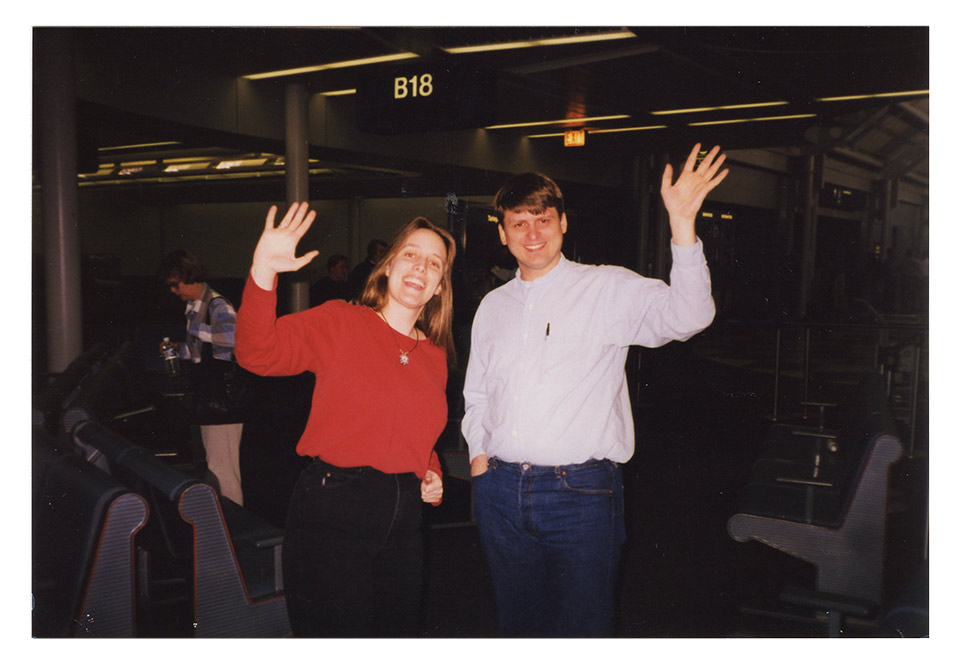
Cathi remembers the trip:
“They flew us out on a red-eye, picked us up at the airport at like, 6AM (their time), and took us to our hotel, where they left us to sleep for about 4 hours. (Then) we spent the afternoon going through mostly ‘creative stuff’…leaving actual ‘contract negotiations’ for the next day. They then took us out to dinner at this really cool ancient restaurant called Grimm’s (funny, the things that stick in your head …) where they proceeded, none too subtly, to try and get us both hammered.
“Poor babies … had no way of understanding, really, all my years in the advertising industry (infamous for the 3-Martini lunch…), and how those years of training and experience basically rendered such an effort moot in my case. 😉 But, man … they went after our big drinker BMAN, big time.”
(Narrator voice: BMAN was not, in fact, a big drinker.)
“So, here we are – about 4 hours of sleep – upside down time zone – just spent all day ‘on stage’ for these people we are asking to give us $1.2M bucks – nice restaurant. They offer (BMAN) wine – (he’s) gonna drink wine – multiple glasses of it. Our boy chokes it down with dinner, and probably thinks he’s off the hook, but noooo. Our hosts then order…large snifters of some very old, very special Armagnac, making clear that this is quite the treat. Armagnac, if you don’t know, is a liquor very much like Cognac or Brandy. It has a very intense flavor, and is pretty brutally high-octane. Those who are into it lovingly warm the glass in their hands, swirl it around, jam their noses into the glass and take a big inhale (think sticking your nose into a bottle of warmed Isopropyl Alcohol), and then slooowly sip at the stuff.
“Which leads to the whole point of this long-winded set-up: the flash frame that lives on in my head of the look BMAN shot me across the table after his first sip, through wide and watering eyes, which could only have translated to something like “Holy Mother of God!! What (the) hell is this?!?”
Needless to say, he smiled and did what was needed.
And the next day, though it took a little time to iron out some details, we essentially walked away with what WE needed …“
And so we returned to the States with the funding we needed and a new business partner. It seemed like a dream come true.
It would be years before we realized that EA had been right about being wary of smaller publishers.
Finding a Valhalla to Call Our Own
Once back in the States we threw a dinner party to announce the deal. We gathered with family and ex-Viacom New Media friends (including the original Septerra team) for dinner and champagne to mark the occasion, a short breather where we could stop for just one night and celebrate our accomplishment before getting to the inevitable hard work required to actually get the game made.
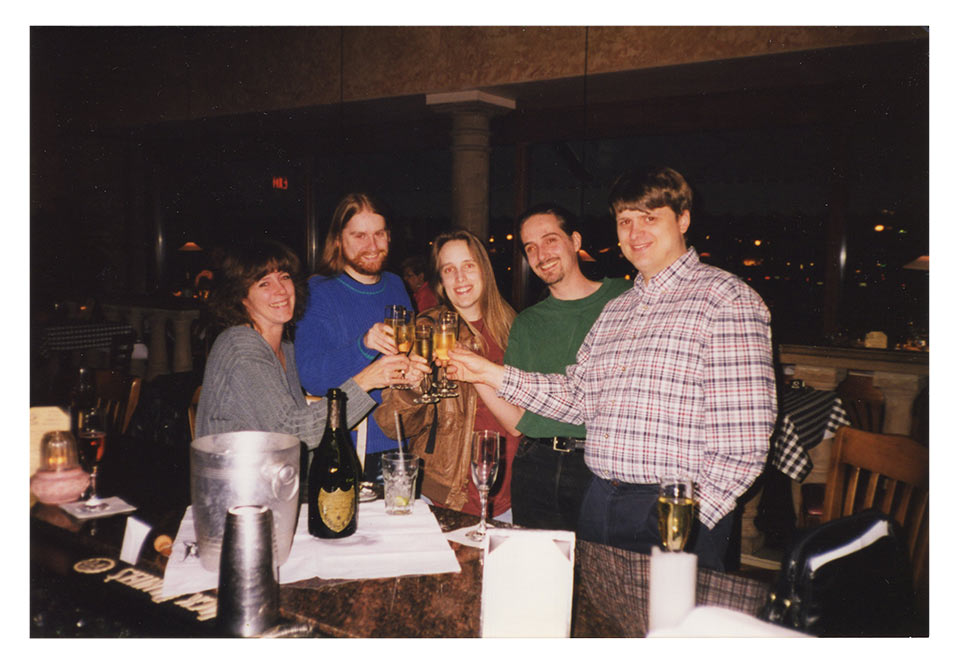
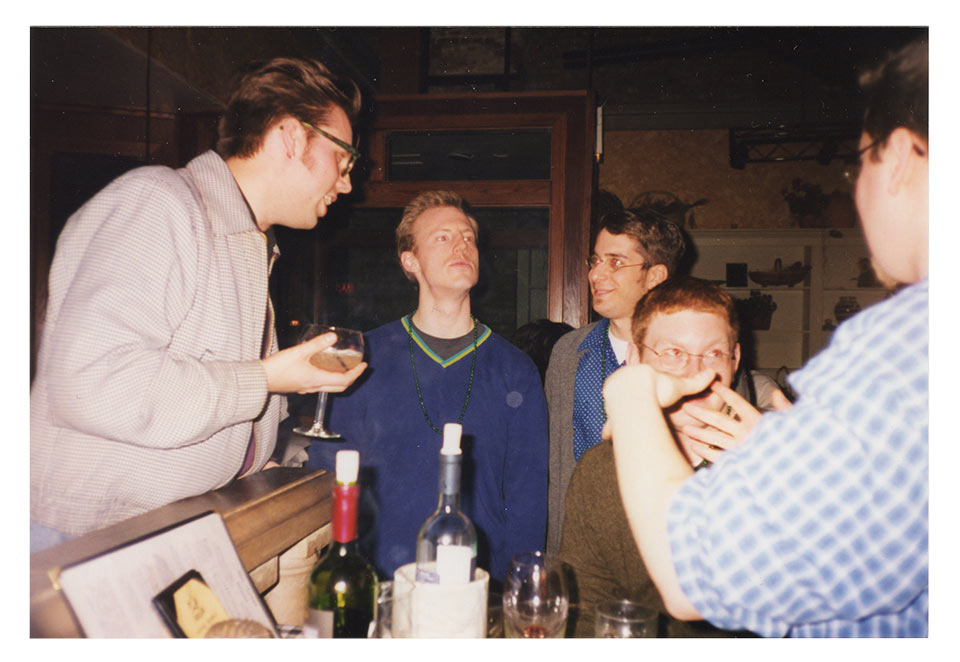
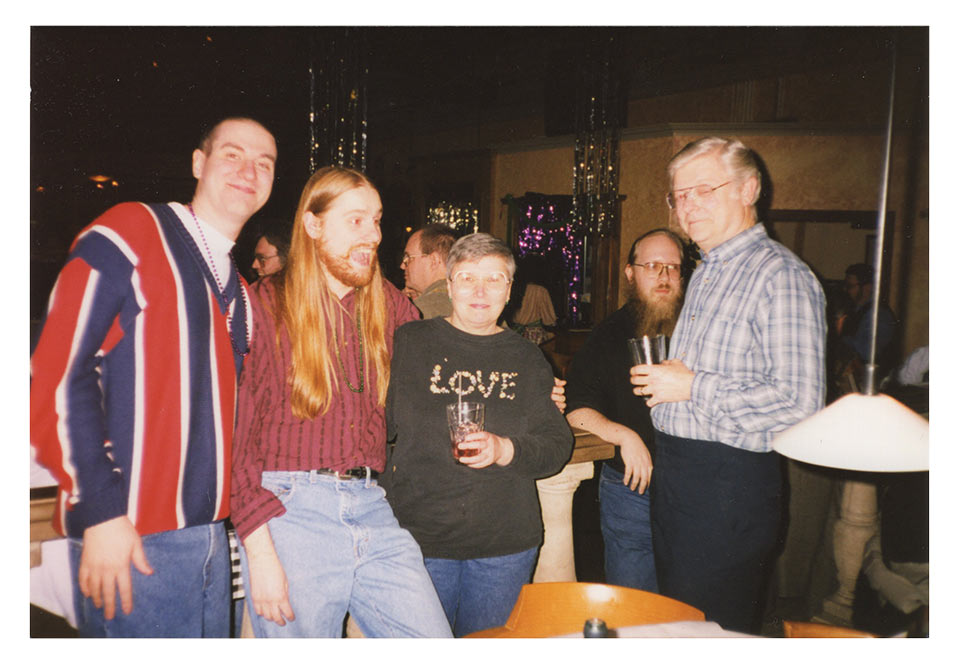
In the dust that settled we had two things: funding and no offices. Our first order of business was to find office space we Valkyries could call home.
We looked far and wide. No seriously, no stone unturned. Cathi got excited about a “cute” rental space that wasn’t like other offices. That’s because it wasn’t an office. it was an old coffee shop! Imagine trying to make a game in an old store front, with cubicles erected where their used to be tables and booths. The other partners (rightly) passed on that.
Another potential space seemed promising, lots of offices and plenty of parking. But it turned out to be a decommissioned laboratory, those offices being hermetically sealed “clean rooms” once used to handle deadly viruses.
Um, no thanks.
Valkyrie Studios eventually ended up finding a home in on old, historic bank building from the 1920’s. The owners in the late 90s were a shipping logistics company, but they only used one of the two floors and were looking to rent out the extra space. It was definitely unique, with the old bank vault converted to a conference room and another vault in the basement.

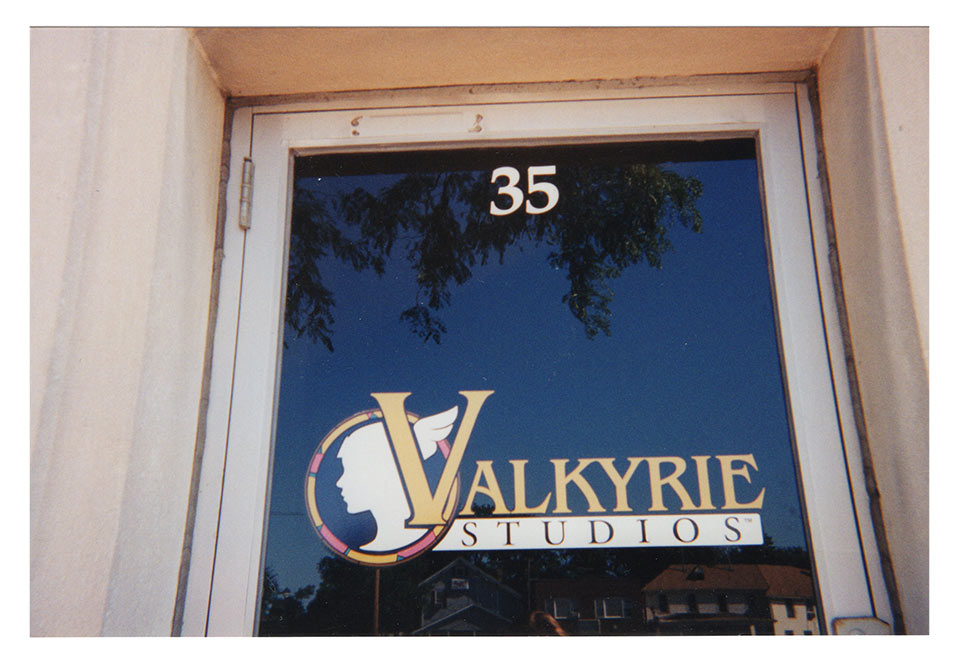

We moved in to the second floor, and began to contact the talented and passionate developers that we needed to bring Septerra Core to life.
But would any of them return?
The Valkyries Assemble
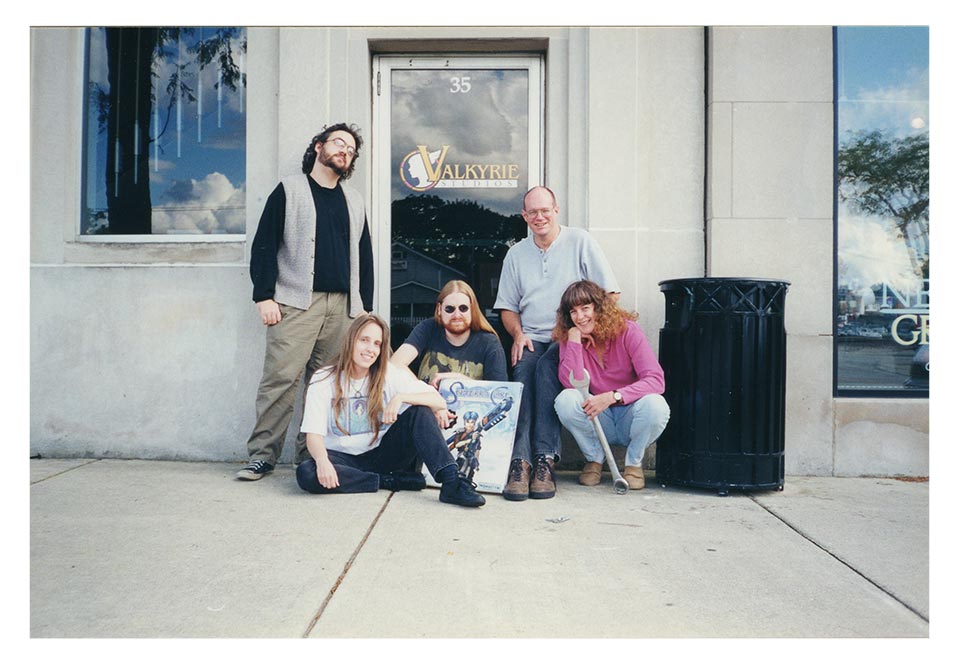
Remember that “nice guy” I had interviewed with when I was looking for work as VNM was closing down, the dude who had insisted that everyone who promised to come back to work for us was just paying us lip service?
I’m happy to say he was wrong.
Dead wrong.
In fact, a few people left his company to come back to us.
We didn’t get the entire VNM team back. Some people couldn’t afford the risk of a start-up, some weren’t interested, and that was cool. But by and large, we put the vast majority of the band back together:
- First, Cathi Court became Valkyrie Studios’s President, dealing with the day to day business of running a company.
- I became Vice President of Game Design, overseeing the creative direction of Septerra Core.
- Alisa Kober took on the role of Vice President of Art Production, overseeing not just the talented teams of artists, but taking on the role of chief scheduler, making sure everyone was keeping up with the tasks of game development.
- Roger D became Vice President of Technology, overseeing the production of game code and tools.
- Jim Weisz, an engineer from VNM also joined us as a principle owner. He had moved into a more management position in recent years, but was eager to get back to programming. As Senior Programmer he would once again get his hands dirty with code, creating the game engine that would drive Septerra Core.
- Kathy, the original lead artist on the game, came back to work as a senior artist specializing in landscapes and interface.
- DaveP was an artist from the Septerra Core team back at VNM, and he jumped at the chance to join Valkyrie.
- Terry S, another talented artist from the VNM team, joined DaveP working on the elaborate background objects that would make our environments so organic and full of detail.
- Jarod Pranno was a talented VNM art and design jack of all trades hired to take on just about anything we could throw at him; in addition to art, he also spearheaded scripting of the enemy AI and helped hone our effects systems.
- Chip S, the young artist who had knocked our socks off back at VNM with his vision for the look and feel of Septerra Core’s environments joined us as well, contributing that edgy coolness to our world in spades.
- Keith B was a talented young artist from VNM who’s kick-ass models and additional character designs would bring many of the game’s characters to life.
- Robb and Gus, who we had plucked from the VNM testing department to work as technical artists, came back to fill those roles at Valkyrie, working together on laying out levels and scripting scenes at “Terrabuilders.”
- Kye, the artist who had provided so many of the original concepts for Septerra Core, was able to come home to Valkyrie as well. Remember that Kye’s situation was unique: he required a work visa to remain in the country. Switching jobs was not easy, and joining a start-up was a particular risk. Kye was willing to take that risk, and that meant a lot to me.
We also hired a few people who had not come from VNM.
- Tonya was a talented animator we had met through a mutual acquaintance from VNM, and she tackled the task of bringing many of our characters to life.
- Ivan, a young modeler and animator looking to get some game development experience, found his first job in the industry with Valkyrie.
- Tony, likewise, was looking to change careers and get into game development. He came on part time as a design intern to learn the ropes and help with scripting, enemy, and sound placement.
Over the next few years this team would become a family, with everyone working on what was to become a labor of love. It was an absolute pleasure to have such talented people bringing this world out of my imagination and into reality, people whose talent at modeling, art, and animation far exceeded my own.
“We were all passionate about making and playing games, and we had a lot of fun. It was a case of ‘do what you love and you’ll never work a day in your life!'”
-Jarod on joining Valkyrie Studios
“Since it was such a small community, when word spread that the rights to Septerra Core were going to move into a new studio – I had to be a part of the project. This was such a great art project – not like the usual sports or 1st P shooters at the time.”
-DaveP on why he took a chance on Valkyrie Studios
“…If you have ever been in a kind of desperate situation and then you are lifted into a situation where you work in a cool office with people you know and you get paid for it… well… it’s really great!”
-Gus on getting the axe at VNM, but then finding a home at Valkyrie Studios.
“I remember the concept wall. The art on there was fantastic, it set the idea of what Septerra Core was about. The breadth of the characters and environments was very inspiring. There was a story to be told and I wanted to read, play it…. to get involved.”
-Ivan on joining Valkyrie Studios

90 Percent Perspiration
At 25 years old I had started my first company and helped secure over a million dollars in funding. It wasn’t something that I had ever seen myself as being capable of. I was the absent-minded professor, more at home in the lab cooking up creative stuff. I helped with the company by-laws, employee handbooks, and business plans, but the other partners did most of the heavy lifting on the business fronts, sort of shielding me from it so I could concentrate on the creative side.
Still, even if I was in charge creatively, I was one of the youngest people at the company. I found myself once again leading a team of developers that included some veterans with 10+ years more experience than me. The word “genius” was thrown around, and a potential investor even took me aside to tell me that I reminded him of a young man he used to know…George Lucas.
Talk about inflating your ego.
And I’m sure I bought into that talk, it’s hard not to when you’re that young and everyone seems to be looking to you to lead the way. But there was another part of me, that spirit animal of Grumpy the Dwarf whispering from just under the surface: “what happens when everyone figures out you aren’t a genius, bro, but just a kid too big for his britches?”
There were now a lot people’s livelihoods and futures directly tied to me and my ability to not screw everything up. That was not just humbling, it was a lot of pressure. But I was determined to rise to occasion. I decided that if “genius” really was 10% inspiration and 90% perspiration, then I would knuckle down and get to work, because everyone was looking to me to lead the way, and I couldn’t let them down.

